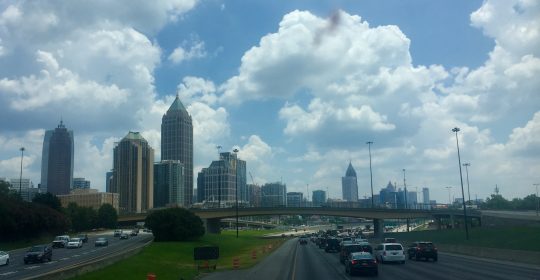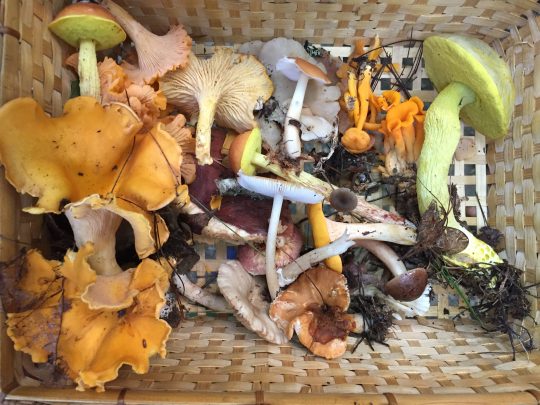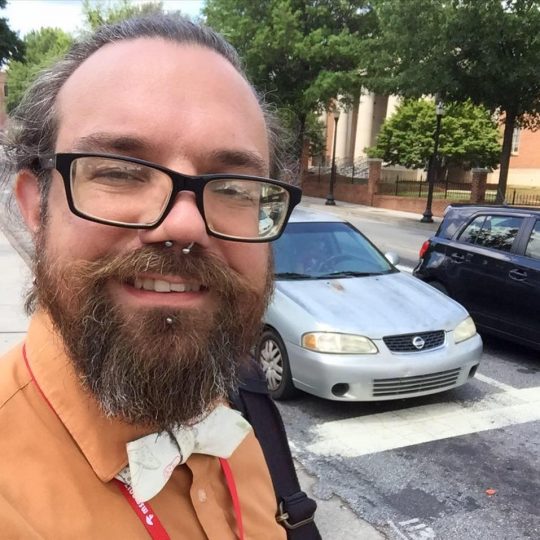In July, one of our own, Dr. Roo Vandegrift, went to the annual Mycological Society of America (MSA) meeting, held just outside of Atlanta, Georgia, in the college town of Athens. He went to learn what others in the field are up to, and present work from the BioBE Center. Roo live-tweeted most of the talks he went to; you can find him @MycoRoo on twitter to look back through his experience of the conference, and look up the hashtag #MSA17 or #MSA2017 to see other posts about the conference.
The meeting started with a pre-conference foray: a group of nearly one hundred mycologists loaded into three packed busses and went out to Unicoi State Park for a 3.5 mile hike; collecting mushrooms, ascomycetes, and plant pathogenic fungi all the way. It has apparently been a particularly wet summer in Georgia so far, and the fungal diversity on display was astonishing, particularly coming from Oregon, where our summers are dry and a bit mycologically deprived.
On Monday morning, the day started with the Presidential Address from outgoing president, Dr. Georgiana May, titled “Lucky: A career in mycology.” She gave a rolling account of a career full of lucky breaks and fortuitous moments, which she made the best possible use of with her sharp and grateful mind. She also included a number of historical anecdotes that had the audience in stitches of laughter, and sometimes on the verge of tears. She asked that the contents of her talk remain private, though, so that’s as much detail as I’ll give here.
The first session of talks that I went to was the Ecology & Conservation section, which started with Terry Henkel presenting some amazing work from his lab on the Thelephoralean ectomycorrhizal fungi of a monodominant tropical forest in the Guyana shield region of South America, and how these fungi may be involved in seedling survival and recruitment in this forest. The discussion of this system continued with the next talk in the session, from Terry’s graduate student, Carolyn Delevich, who gave a fascinating discussion of the community assembly of ectomycorrhizal fungi on the roots of these dominant Fabaceae trees, looking at the change in the community over time on the seedlings from one of these mass fruiting events.
EcM diversity increases as you move AWAY from the equator — counter to most other diversity trends. But some exceptions, eg Guyana. #MSA2017
— Roo Vandegrift (@MycoRoo) July 17, 2017
There were a number of other excellent talks about mycorrhizal communities, highlighting the cutting edge of molecular techniques in fungal community ecology, host-associated dynamics, and spatial/temporal ecology. Dr. Alija Mujic’s talk on invasion dynamics in mycorrhizal communities of Nothofagus in Patagonia was particularly good.
At the end of that first day, Roo presented his talk: “Impacts of Weatherization on Indoor Fungal Communities“, co-authored with other BioBE personnel, as well as colleagues from the Oregon Research Institute and Northwestern University (Roo Vandegrift, Ashkaan Fahimipour, Jeff Kline, Alejandro Manzo, Dale Northcutt, Jason Stenson, Hannah Wilson, Ryann Crowley, Erica Hartmann, Deborah Johnson-Shelton, G.Z. Brown, Jessica Green, Kevin Van Den Wymelenberg). This talk debuted preliminary data from our EPA-funded study examining a multi-faceted, interdisciplinary dataset combining microbial ecology, indoor air quality, and an extensive survey detailing aspects of health and behavior. Feedback was incredibly positive and encouraging, including some really helpful feedback on biophysical explanations for observed trends in the data.
There were a handful of other talks that stood out as particularly important or impactful. Mara DeMers, from the University of Minnesota, Twin Cities, presented on endophytic fungi in prairie plants, and whether molecular OTUs (or ESVs, for that matter) correspond to species; she asks the question does it matter if they do? She was particularly vexed by the genus Alternaria, which made up most of her endophyte sequences, and appears to be non-resolvable into meaningful groupings via ITS alone — the region is so variable in this group (and other!), that the intra-strain variation is as great as the inter-strain variation, meaning that the same sequence may belong to totally different strains, while very different sequences may belong to extremely closely related individuals. This is an important caution for the field, and one we at the BioBE Center will certainly keep in mind!
ITS OTUs don't map well to species or sections within Alternaria. Variation at the ITS locus doesn't match multi-locus variation. #MSA2017
— Roo Vandegrift (@MycoRoo) July 17, 2017
Take-home: ITS only can be misleading, sometimes. #MSA2017
— Roo Vandegrift (@MycoRoo) July 17, 2017
Among the amazing talks, excellent company, and stimulating scientific conversations, Dr. Regine Kahmann (from Max Planck Institute for Terrestrial Microbiology) presented the the Karling Lecture, titled “Core Effectors in Smut Fungi: An Amazing Treasure Box.” This was an incredible summary of her life’s work on the molecular mechanisms underlying the pathogenicity and ecology of smut fungi (Ustilagomycota). The careful, methodical, innovative science on display during her talk was breathtaking, and an inspiration.
Mating and pathogenicity are intimately linked in U. maydis. This process happens only inside the plants. #MSA17
— Roo Vandegrift (@MycoRoo) July 18, 2017
One other talk strikes me as worth explicit mention here: Jesse Uehling’s discussion of how to re-purpose archived data in new ways. I think there’s an important lesson here; we are generating sequence data much more rapidly than we are currently exhausting the ways that such data can be explored, and the techniques for exploring that data are evolving extremely rapidly. As Jesse says, there may be treasure in that trash!
Jessie Ueling (@JessieUehling) presents "Data dumpster diving in the fungal -omics era". #MSA17
— Roo Vandegrift (@MycoRoo) July 19, 2017
One idea from her talk that struck me as particularly significant was that the “junk” reads from genomic assemblies are typically reads representing the microbiome of whatever organism was sequenced. It is certainly worth considering that there may be a large quantity of un-examined microbiome data available from a wide range of organisms, if we only go looking through the available raw data. And, the assembly of small bacterial genomes from mixed starting templates has been well demonstrated.
Assembly of multiple genomes from mixed starting templates: great for (simple?) microbiomes! See: https://t.co/GQZ7va4fP5#MSA17
— Roo Vandegrift (@MycoRoo) July 19, 2017
There were many other noteworthy aspects to this meeting; it is worth browsing the #MSA17 tweets if you’re interested. We hope for many more productive, fascinating meetings like this in the future!
~~


